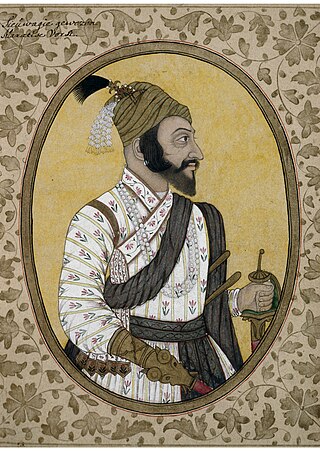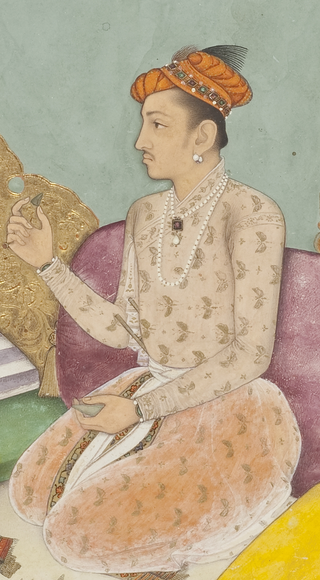| Second Sack of Surat | |||||||
|---|---|---|---|---|---|---|---|
| Part of Maratha-Mughal War | |||||||
 Early 20th century depiction of the Sack of Surat by Shivaji. | |||||||
| |||||||
| Belligerents | |||||||
| | | ||||||
| Commanders and leaders | |||||||
| | | ||||||
| Strength | |||||||
| 15,000 cavalry | 5,000 garrison troops | ||||||
| Casualties and losses | |||||||
| Unknown | Unknown | ||||||
The Second Sack of Surat took place in October 1670 when forces of the Maratha Empire, led by Chhatrapati Shivaji, attacked and looted the prosperous Mughal port city of Surat for the second time. [1] The raid was a part of the ongoing Maratha-Mughal War and resulted in a decisive victory for the Marathas. Shivaji, commanding 15,000 cavalry along with his prominent generals such as Prataprao Gujar, Anandrao, and Moropant Pingle, advanced from Kalyan, following the same route as his previous attack in 1664. Upon reaching the gates of Surat on 3 October 1670, the city's defenders, including the Mughal governor Bahadur Khan, were unable to effectively resist the attack, leading to the plundering of the city.
During the raid, the Marathas seized a substantial amount of wealth, causing significant economic damage to the city of Surat. Despite the widespread devastation, major foreign trading establishments, including those of the English, Dutch, and French, were spared from destruction. After three days of extensive looting, Shivaji withdrew from the city, leaving behind a letter demanding an annual tribute from the merchants of Surat. [2] [3] [4]
From January to September, the Mughal government was effectively paralyzed. Adding to their troubles, they received alarming news that Shivaji had struck Surat with devastating force once again. Shivaji, leading an army of 15,000 cavalry and an equal number of infantry, accompanied by prominent generals and officers such as Prataprao Gujar, Anandrao and the Peshwa Moropant, advanced from Kalyan. He followed the same route as during his previous attack on Surat, passing through what are now the Thane, Nasik, and Dang districts. On October 3, 1670, Shivaji arrived at the walls of Surat, forcing the defenders to flee under the protection of the castle's artillery. [5] [6] [3] [4]
In March and April 1670, Surat faced repeated warnings of an impending attack by Shivaji. On March 16, the Surat Council decided to request 35 to 40 Portuguese soldiers and 6 or 7 English file leaders from Mumbai to protect their factory. While Mumbai agreed to this request, they expressed concern in their March 29 letter about losing so many men given Shivaji's proximity. By mid-April, 39 Portuguese soldiers, a sergeant, and four English soldiers had arrived in Surat. However, when Bahadur Khan, the subadar of Gujarat, arrived with 5,000 horsemen, the threat seemed to diminish, leading the Surat Council to decide on April 25 to send the soldiers back to Mumbai. [5] [6] [3] [4]
Fresh warnings of Shivaji’s attack emerged in September. On September 12, the Surat Council resolved to swiftly move all goods to Swally by various means, fearing Shivaji's approach. This decision was driven by the merchants' eagerness to convert their goods into money for easier transport. On September 16, it was noted that merchants were willing to sell their goods at lower rates due to the ongoing fear of Shivaji's preparations. [5] [6] [3] [4]
On October 3, 1670, Shivaji, leading 15,000 troops, reached Surat's gates. On October 2, the English Council at Swally, having received urgent news of Shivaji's approach, decided against sending President Gerald Aungier to Surat for defense. Instead, 40 men from the Company's ships were dispatched with Streynsham Master to protect the factory. The master and his men reached Surat at night, with about 10 remaining on a hoy for a potential retreat. [5] [6] [3] [4]

When Shivaji's army arrived and briefly attacked Surat, the defenders fled to the castle, leaving the city vulnerable. The Marathas looted and burned large parts of the city, sparing only the English, Dutch, and French houses, as well as the Serais. The English house, defended fiercely, was spared from direct attack, while the Marathas turned their attention to the Old Serai, occupied by the Tartar King. The French, despite having ample resources and men, chose to appease Shivaji through gifts and did not resist the Marathas, who were rumored to have received assistance from the French. [5] [6] [3] [4]
Shivaji's forces left Surat on October 6, 1670, after plundering the city. He left a letter threatening further destruction if a tribute of twelve lakh rupees was not paid annually. After the Marathas departed, local residents began plundering the remaining property, leading to further chaos. [5] [6] [3] [4]
The English seamen, stationed for defense, were later reprimanded for their behavior towards local estates. Streynsham Master's efforts and bravery were recognized with a gold medal from the Company in 1672. The immense spoil taken from Surat was valued at Rs.6.6 million, but the city's long-term damage was severe. Continuous alarms from Shivaji's forces disrupted trade, leading to a decline in Surat's commercial prominence as merchants began shifting to Mumbai, which offered greater security and economic advantages. [5] [6] [3] [4]
"The Marathas possessed themselves of the whole town. The Tartars could keep their houses no longer, but in the night, having conveyed away their King to the castle, left their house a prey to Shivaji, where he found a vast treasure in gold, silver, rich plate, a gold bed and other rich furniture. In the interim, the enemy ransacked the great houses at leisure and found therein vast treasures and rich goods; set fire in several places destroying near-half the town to the ground."









